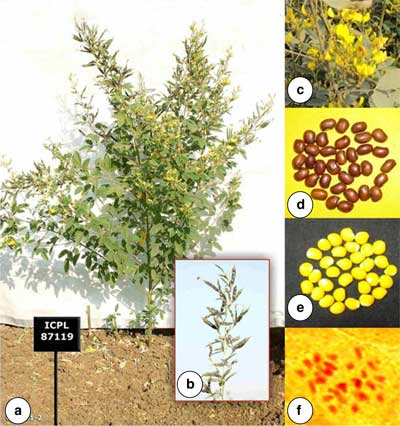Paving the Way for Green Revolution in Pulses
New Delhi, 2nd November 2011
A group of thirty-one Indian scientists from ICAR Institutes, State Agricultural Universities and Banaras Hindu University, led by Prof. Nagendra Kumar Singh from ICAR’s National Research Centre on Plant Biotechnology at New Delhi have decoded the genome of ‘Arhar’, the second most important pulse crop of India. This is the first plant genome sequenced entirely through a network of Indian institutions and it will provide highly valuable resource for variety improvement of pigeonpea.
Institutions involved
- National Research Centre on Plant Biotechnology (ICAR), New Delhi
- Indian Agricultural Research Institute (ICAR), New Delhi
- Indian Institute of Pulse Research (ICAR), Kanpur, UP
- Banaras Hindu University, Varanasi, UP
- Panjabrao Deshmukh Krishi Vidyapeeth, Akola, Maharashtra
- University of Agricultural Sciences, Dharwad, Karnataka
Average pulse crop productivity in India has remained low at about 650 kg per hectare for the last six decades leading to soaring ‘Dal’ prices with increasing demands. Lack of high yielding, disease and pest resistant varieties is a major factor for the stagnant pulse productivity. Slow progress in breeding high yielding Arhar varieties is attributed to dearth of genetic information coupled with large crop duration and intractable pod borer problem and poor utilization of wild germplasm resources. Development of DNA markers tightly linked to important agronomic traits is a prerequisite for undertaking molecular breeding in crops. Availability of the Arhar genome sequence will accelerate development of new varieties and hybrids with enhanced productivity by making use of germplasm resources, in a way similar to the rice genome experience.
The genome of popular Arhar variety ‘Asha’ was assembled using long sequence reads of 454-FLX second generation sequencing technology resulting in 511 million base pairs of high quality genome sequence information. The scientists have identified 47,004 protein coding genes in the Arhar genome, of which 1,213 genes are for disease resistance and 152 genes for tolerance to drought, heat and salinity that make it a hardy crop. In contrast to soybean, Arhar has fewer number of genes for oil biosynthesis and larger number of genes for cellulose biosynthesis which make it an oil-free woody plant. The genome sequence was used to develop a large number of ‘Arhar’ DNA markers which were experimentally validated for high rate of variation among the pigeonpea varieties. These markers will be useful for DNA fingerprinting and diversity analysis of pigeonpea germplasm and molecular breeding applications.
Until a couple of years ago pigeonpea was considered an orphan legume crop because developed countries would not invest in the research due to the crop being cultivated mainly in the tropical and subtropical countries but now substantial amount of genomic resources have been generated, largely due to the efforts of Indo-US Agricultural Knowledge Initiative (AKI) and Network Project on Transgenics in Crops (NPTC) both with funding support from the ICAR.
Pigeonpea or red gram (‘Arhar’ or ‘Tur’) is an important grain legume (Pulse) crop of India. About 85% of the world pigeonpea is produced and consumed in India where it is a key crop for food and nutritional security of the people. India imports pigeonpea from Myanmar which is the second largest producer. The world acreage of pigeonpea is about 4.90 mha with annual production of about 4.22 mmt worth about 1.5 billion US dollars. India is the largest producer, consumer and importer of pigeonpea with annual production of 3.07 mmt, followed by Myanmar (0.72 mmt) and Malawi (0.15 mmt) (FAOSTAT 2008).

The whole plant and different parts of the pigeonpea cultivar 'Asha' (ICPL 87119). a. whole plant at fruiting stage; b. a defoliated branch with pods; c. a branch with heavy flowering; d. mature seeds; e. dehusked split seeds or 'Dal'; f. 22 chromosomes in a root tip cell








Like on Facebook
Subscribe on Youtube
Follow on X X
Like on instagram